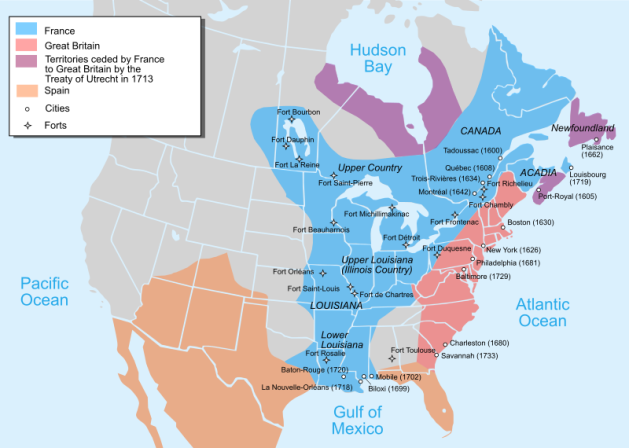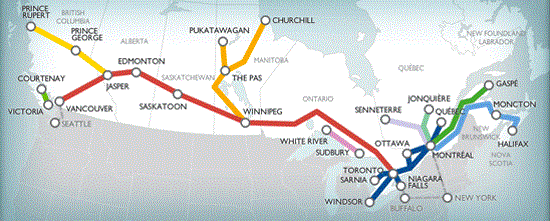All the things you ever wanted to know about the province of Manitoba but were afraid to ask…..
Origin of the name “Manitoba”: of First Nations (Native American, for US speakers) origin, possibly from the Cree manitou-wapow or from the Ojibwa manidoobaa, both meaning “straits of Manitou, the Great Spirit”, a place referring to what are now called The Narrows in the centre (remember, this is Canada) of Lake Manitoba. Alternative: from the Assiniboine for “Lake of the Prairie”
 If Minnesota is the Land of Ten Thousand Lakes, then this map of Manitoba shows that it must be the land of 100,000 lakes. That guess apparently isn’t far off; the provincial government claims about 110,000 lakes within the borders of the province.
If Minnesota is the Land of Ten Thousand Lakes, then this map of Manitoba shows that it must be the land of 100,000 lakes. That guess apparently isn’t far off; the provincial government claims about 110,000 lakes within the borders of the province.
Just barely smaller than Texas in area (250,000 mi2 v. 268,000 mi2 for Texas)
Little over a million citizens, with 3 of 5 living in the provincial capital of Winnipeg
“Winnipeg” means “big muddy waters.” “Winnipegosis” is the diminutive of Winnipeg, meaning “Little Muddy Waters.”
 Lakes Winnipeg, Manitoba, and Winnipegosis are the remnants from the bottom of the glacial Lake Agassiz, which caused several floods in the mid-Holocene up to about 5000 BCE, and is credited in some theories for shutting down the Gulf Stream and brought cold and drought to Europe and the present Middle East.
Lakes Winnipeg, Manitoba, and Winnipegosis are the remnants from the bottom of the glacial Lake Agassiz, which caused several floods in the mid-Holocene up to about 5000 BCE, and is credited in some theories for shutting down the Gulf Stream and brought cold and drought to Europe and the present Middle East.
Lake Winnipeg is one of the most undeveloped lakes in the world, and is the 12th largest in area.
For many years, Winnipeg was the third largest city in Canada because of the TransCanadian railway for transporting goods across the Americas. Declined after 1914 when Panama canal was opened, overtaken by Vancouver in the 1920’s. Now it’s the 7th or 8th largest city in Canada.
Much of Manitoba’s 18th century history reflected a battle between the British fur traders of the Hudson’s Bay Company based along Hudson’s Bay (what a surprise) and the French fur traders who moved up to the area of Winnipeg and Lakes Winnipeg, Manitoba, and Winnipegosis.
Red River Rebellion was a major civil war between Métis (people of mixed First Nation and European heritage) and European (and largely Protestant) arrivals.
Many French Fries in American fast food were raised as potatoes and processed into French Fries in Manitoba.
Like all Canadian provinces, Manitoba has a unicameral legislature
English and French are both official language of the state, although English is more commonly spoken
Winnipeg, with a population about 700,000, has 3 daily newspapers. Los Angeles, with a regional population many times that of Winnipeg, has two major daily papers (but only if you continue to count the Los Angeles Times as a newspaper)
Most of what is now the province of Manitoba was, until 1912, the Department of Keewatin in the Northwest Territories (“Keewatin” is a Cree word meaning “Blizzard of the North”). In 1912, the present provinces of Alberta, Saskatchewan, and Manitoba were all formed (same year that Arizona and New Mexico became states). Pre-1912 Manitoba was a tiny province limited to the area around Winnipeg.
Sports teams in Manitoba usually have wonderful names:
 Winnipeg Blue Bombers (Canadian football). Great name, but the logo is a white-and-blue W? Not living up to your potential! Much better are the Winnipeg Rifles of the Canadian Junior Football League.
Winnipeg Blue Bombers (Canadian football). Great name, but the logo is a white-and-blue W? Not living up to your potential! Much better are the Winnipeg Rifles of the Canadian Junior Football League.
- Winnipeg Jets (hockey) OK, this name isn’t so great, though the original team moved to Phoenix in 1996 and is now known as the Coyotes, which is much better! AND they were replaced by the Manitoba Moose for about 5 years, the only team I’ve heard of whose plural is the same as its singular, which moved to St. John’s in 2011 and became the IceCaps. The current hockey team is again the Jets, although they were the Atlanta Thrashers before they moved to Winnipeg in 2011. Sigh.
 Winnipeg Goldeyes (baseball), whose name/mascot is awesome beyond belief: a non-aggressive fish that fly-fisherman consider too small to be worth catching! The fish does apparently have a golden eye, and hence the name.
Winnipeg Goldeyes (baseball), whose name/mascot is awesome beyond belief: a non-aggressive fish that fly-fisherman consider too small to be worth catching! The fish does apparently have a golden eye, and hence the name. University of Manitoba Bison (hey, Manitoba is one of the prairie provinces; what better mascot?)
University of Manitoba Bison (hey, Manitoba is one of the prairie provinces; what better mascot?)








